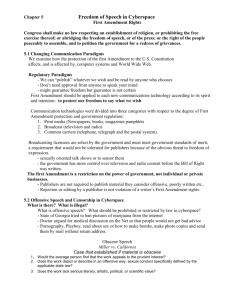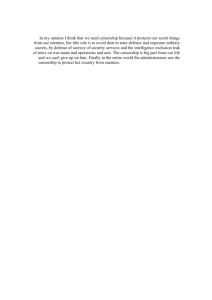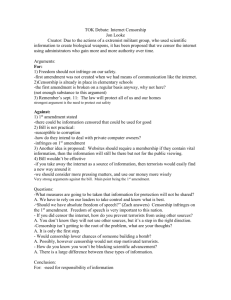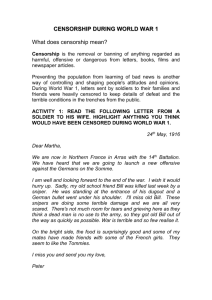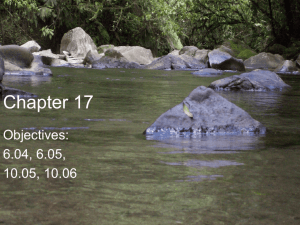Introduction to Design
advertisement
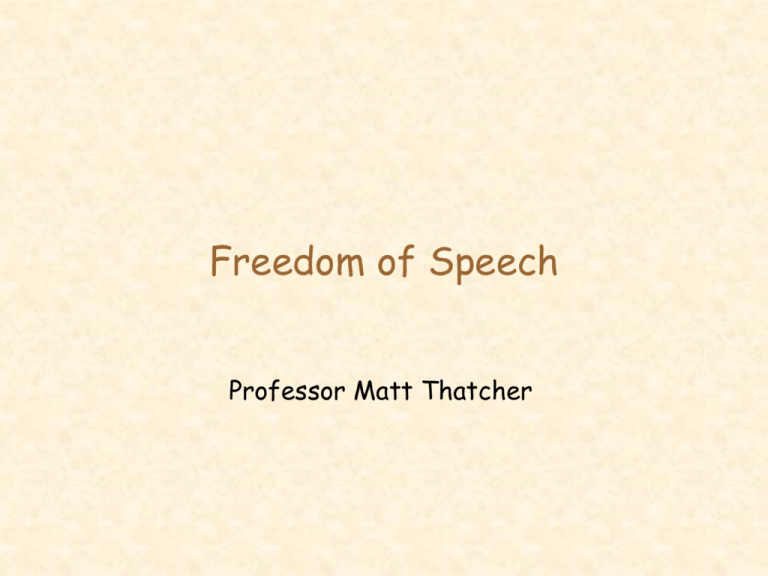
Freedom of Speech Professor Matt Thatcher Last Class Workplace privacy – how is electronic monitoring different from traditional monitoring? – types of electronic monitoring – U.S. vs. European laws on workplace privacy – benefits and criticisms of electronic monitoring – electronic monitoring guidelines for management 2 Today Administrative – – – – turn in Case Report (3) return Term Paper Proposals return Case Report (2) thank you for the feedback Freedom of Speech – what is the First Amendment? – what types of speech are not protected? – offensive speech and censorship in cyberspace » U.S. laws vs. technology solutions – hate speech – SPAM 3 The First Amendment Protects citizens from government – prohibits restriction of speech, press, peaceful assembly, and religion by government – 1st Amendment is a restriction on the power of government, not individuals or companies Subsequent interpretations address: – offensive and/or controversial speech and ideas – spoken and written words – pictures, art, and other forms of expression and opinion (flag burning, hand gestures, dance movements) – commercial speech (e.g. advertising) 4 The First Amendment Supreme Court has held that the following types of speech are not protected by the 1st Amendment – – – – – obscene speech defamation incitement of panic incitement of crime (threats) inciting rebellion against the government (sedition) 5 Obscene Speech Miller v. California (1973) – established a test to determine if material is considered obscene – material is obscene if: 1. It depicts sexual (or excretory) acts whose depiction is specifically prohibited by state law, and 2. It depicts these acts in a patently offensive manner, appealing to the prurient interest as judged by a reasonable person using community standards, and 3. It has no serious literary, artistic, social, political, or scientific value. – who is a reasonable person? what are community standards? what does this imply for potentially obscene material posted on the internet? 6 Defamation Freedom of expression is restricted when the speech is: – untrue and causes harm to another person Slander – oral defamatory statement Libel – written oral defamatory statement 7 The First Amendment: Changing Communications Paradigms Regulatory Paradigms – communication technologies differ with respect to their degree of First Amendment protection and government regulation. – print media (newspapers, books, magazines) » strongest First Amendment protection – broadcast media (television, radio) » less First Amendment protection than print media (why?) » cigarette ads, FCC violations, the “seven dirty words”, warning labels for music – common carrier (telephone, telegraph, postal system) » content not controlled and the carrier is not responsible for content 8 What about the Internet? Internet infrastructure – lacks content controls and censorship – is oblivious to geographic boundaries – is about free speech on a very large scale » it empowers the individual to send anything anywhere Courts have suggested that: – “As the most participatory form of mass communication yet developed, the Internet deserves the highest protection from government intrusion.” [ACLU v. Reno] But efforts to censor speech on the internet continue 9 Offensive Speech and Censorship in Cyberspace Material inappropriate for children – pornography can be regulated and banned, but only for minors – technology changes the context » on the Web, children have access to the same ‘adult’ text, images, videos, etc. as adults. » online proprietors don’t know the customer is not an adult. – protecting children » regardless of the medium: it is illegal to create, possess or distribute child pornography. it is illegal to lure children into sexual activity. 10 Offensive Speech and Censorship in Cyberspace Censorship Laws – Communications Decency Act (CDA, 1996) » publicity and public pressure lead Congress to pass this act. » anyone who made available to anyone under 18 any communication that is obscene or indecent would be subject to a $250,000 fine and two years in prison. » In 1997, the CDA was ruled unconstitutional because it was too vague and too broad in protecting children online and because less restrictive means are available [ACLU v. Reno (Feb 1996)] 11 Offensive Speech and Censorship in Cyberspace Censorship Laws (cont’d) – Child Online Protection Act (COPA, 1998) » commercial Web sites that make available to minors materials “harmful to minors”, as judged by community standards would be subject to a $50,000 fine and six months in jail » used Miller v. California (1973) definition of obscene » In 2000 and 2003, COPA was ruled unconstitutional by a federal court (definition of obscene speech still to broad) » In 2004, COPA was ruled unconstitutional by the Supreme Court 12 Offensive Speech and Censorship in Cyberspace Censorship Laws (cont’d) – Children’s Internet Protection Act (CHIPA, 2000) » any school or library receiving federal Internet funds must install filtering software on all Internet terminals » filters must block sites containing child pornography, obscene material, and any material deemed “harmful to minors” » A federal appeals court ruled a major part of CHIPA unconstitutional in 2002 but the Supreme Court upheld the law in 2003 – problems » does this hand power of education to software companies? » filter company can track and sell web surfing data 13 » disproportionately hurts poor schools that need e-rate Offensive Speech and Censorship in Cyberspace Limiting Internet Access in Libraries and Schools – Filtering Software » Benefits: prevent access to inappropriate material on the Internet by screening words or phrases, blocking sites according to rating system, or disallowing access to specific sites in a list. » Problems: can be ineffective—kids get around the filters; the words, phrases, rating systems, etc. are subjective; “banned” keywords can be overly restrictive for adult users and for legitimate use by minors, not transparent 14 Offensive Speech and Censorship in Cyberspace Types of filtering – URL filtering – keyword filtering – dynamic content filtering Popular Filters – ConnectProtect, CYBERsitter, CyberPatrol Internet Content Rating Association (ICRA) – http://www.fosi.org/icra/ – self-rating of content via an ICRA questionnaire (essentially self-regulation) 15 Spinello Cases Multnomah Public Library et al. v. U.S. Censorship at New England University 16 Hate Speech U.S. perspective – hate speech is completely protected (unless direct threat that will result in “imminent lawless action”) – Jake Baker (Spinello), Nuremberg Files (Planned Parenthood v. ACLA) European perspective – stringent anti-hate laws (so where do you think most hate websites are hosted?) – Germany » ISPs must block hate sites or face prosecution » illegal for firms in other countries to make hate speech available to Germans [Compuserv Deutschland (Spinello)] – France » illegal to display or sell objects that represent racism or ethnic hatred ( including WWII Nazi memorabilia) » e.g., Yahoo and the auction on the American Website – Saudi Arabia [Veil of Censorship (Spinello)] 17 Student Websites Schools can control – – – – school newspapers issues related to extracurricular activities profane speech within school can curtail off campus speech if it causes a “material and substantial” disruption in the classroom » school may restrict speech and expel students if a student has a site that threatens a teacher or student at the school The case of Sean O’Brien 18 SPAM What Is the Problem? – Unsolicited, mass e-mail: » is cheap to senders but may impose costs on the recipient’s time and/or the recipient’s online account. » may contain objectionable content (political, commercial ads, solicitations for funds, pornography, etc.). » may contain a disguised return address. » may pass through filters. » invades privacy. » creates a financial and managerial burden on ISPs. How do you handle spam? 19 SPAM Cases and Free Speech Issues – AOL v. Cyber Promotions » AOL and other service providers have successfully sued spammers because of the cost burden imposed. – Disgruntled Intel Employee » initially, a court ruled that non-commercial spam to Intel employees at their Intel e-mail accounts was a form of trespass – seen as junk mail that disrupted Intel employees’ work » the CA Supreme Court ruled that it was not. 20 SPAM Can firms filter spam? – of course Solutions – technology: filters that screen out spam – market Pressure: services that list spammers – business Policy: at the discretion of the recipient, all e-mail would be charged a microfee – law: create restrictions that are consistent with the First Amendment » CAN-SPAM 21 Exam 1 Professor Matt Thatcher Instructions for Exam 1 This exam will be closed-note and closed-book. You will be given 120 minutes to complete it. All exams must be turned in at the end of the exam period. Do not discuss any aspects of the exam with other students until after they have taken it. Doing so is considered cheating. The exam will have 6-10 questions and is worth a total of 100 points. Point allocations are provided after each question. Manage your time accordingly. Remember that you cannot receive partial credit if you leave the answers blank. Please put your answers in the spaces provided. If you need more space for an answer please use the three (3) extra pages provided at the end of the exam. 23 Format of Exam 1 Short answer (very few) Short essay (6 – 10 questions) – compare and contrast – explain course concepts – constructing examples of course concepts » case examples, personal experiences – example situations » analyze the situation similar to case reports what is the moral dilemma? who are the stakeholders? what are some possible actions and their consequences for each stakeholder? what is the “right” action in this situation? 24 Tips for Preparation Before the exam – – – – review readings and notes list concepts group similar concepts together make up exam questions » why is this concept important? » how does it fit into the big picture? » can I compare this concept to other similar ones? If so, then how is it different? » what is a real world example of this concept? » what are some potential solutions to a given moral dilemma? What stakeholder would support each solution? Why? During the exam – read questions carefully – manage your time carefully 25 Exam 1: Topic List Frameworks for Ethical Analysis (Class 1) – slides 12-17 » compare and contrast the teleological and deontological perspectives » how does each perspective determine the “right” action? » what are the problems with applying each perspective to a situation? Newly Vulnerable Markets (Class 2) – – – – slides 4-5, 14-16 what are the 3 characteristics of a newly vulnerable market? what is the customer profitability gradient? the case of Capital One Financial » good idea to read back through the “Capital One” case » what happened? why did it happen? can it keep happening? where else can it happen? – recording industry, newspaper industry 26 Exam 1: Topic List Consumer Information Privacy (Class 3) – how would you write a website’s privacy policy? » FTC Consumer Fair Information Practices » notice, choice, integrity, access, enforcement, (not accountability) – compare and contrast European and U.S. approaches to consumer privacy » European Data Protection Directive: Directive 95/46/EC and the Safe Harbor Program » E-Privacy Directive: Directive 2002/58/EC » industry solutions (e.g., privacy seal programs) » technology solutions (e.g., P3P) » privacy norms (industry) vs. privacy policies (firm) vs. law (govt) vs. technology and education (consumer) 27 Exam 1: Topic List Workplace Privacy (Class 4) – how has IT changed employee monitoring? – identify and describe various electronic monitoring applications. – discuss the advantages and disadvantages of electronic monitoring of employees in the workplace – U.S. Workplace Privacy Laws » Electronic Communications Privacy Act of 1986 (ECPA) – what are some good guidelines to follow when setting an electronic monitoring policy in the workplace 28 Exam 1: Topic List Freedom of Speech (Class 5) – what is the First Amendment? – what types of speech are protected and which are not protected? – offensive speech and censorship in cyberspace » U.S. laws vs. technology solutions – hate speech 29 Next Time Exam 1 30
